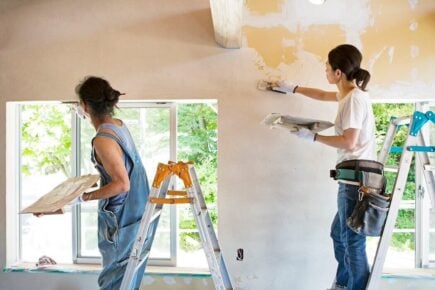Many or all of the products and brands we promote and feature including our ‘Partner Spotlights’ are from our partners who compensate us. However, this does not influence our editorial opinion found in articles, reviews and our ‘Best’ tables. Our opinion is our own. Read more on our methodology here.
Stamp duty is a tax that you may have to pay as a homebuyer purchasing a property or land. Stamp duty rates vary according to the purchase price of the property being bought and your status as a buyer, including whether you’re buying for the first time or purchasing an additional property. Sometimes stamp duty doesn’t need to be paid at all.
Read on to learn more about what stamp duty is, who has to pay it, and when it’s paid.
Think carefully before securing other debts against your home. Your home may be repossessed if you do not keep up repayments on a loan or any other debt secured on it
What is stamp duty?
Stamp Duty Land Tax (SDLT), or stamp duty for short, is a tax you pay when buying a residential home or piece of land in England and Northern Ireland.
Stamp duty also needs to be paid on non-residential property and land, but at different rates.
The tax applies to both freehold and leasehold properties that you may purchase outright or with a mortgage.
Scotland and Wales have their own versions of property tax, which are similar to stamp duty, but with different rules and rates. In Scotland home buyers pay Land and Buildings Transaction Tax, while in Wales there is Land Transaction Tax.
How much is stamp duty?
A number of factors determine the amount of stamp duty you may have to pay. There are different stamp duty rates and thresholds based on how much a property costs. Standard rates range between 5% and 12%, but if a property costs less than £250,000, you can avoid paying stamp duty altogether. If you’re a first-time buyer, different thresholds apply and you could qualify for stamp duty relief – and if you pay under £425,000 for your first home there may be no stamp duty to pay at all. On the other hand, if you’re buying an additional property, alongside one you own already, standard stamp duty rates are increased by 3%.
Where you are buying in the UK can affect the stamp duty you pay too. Scotland and Wales each have their own stamp duty equivalents, each with their own rates and thresholds.
Our stamp duty calculator can help you work out how much you may need to pay in the different parts of the UK, including if you’re a first-time buyer.
Stamp duty thresholds and rates in England and Northern Ireland
The table below shows current stamp duty rates and thresholds for buyers in England and Northern Ireland.
| Property purchase price | Stamp duty rate |
|---|---|
| Up to £250,000 | 0% |
| £250,001 to £925,000 | 5% |
| £925,001 to £1.5 million | 10% |
| Over £1.5 million | 12% |
Source: Gov.uk
In the Autumn Statement 2022, Chancellor Jeremy Hunt announced the nil-rate threshold below which stamp duty isn’t paid will revert to £125,000 with effect from 1 April 2025, the level from which it rose following the mini-budget.
How is stamp duty calculated?
Stamp duty is calculated in a similar way to income tax in that it uses a ‘tiered structure.’
This means the same level of tax isn’t applied to the total property price. Instead, you’ll pay tax on each portion of the property price that falls into the different stamp duty tax bands.
So if you bought a house for £300,000, you would need to pay stamp duty of:
- 0% on the first £250,000 = £0
- 5% on the next £50,000 = £2,500
- Total: £2,500.
» MORE: Calculate how much stamp duty you may pay
Who pays stamp duty?
Stamp duty is always paid by the person buying the property. Typically, your solicitor or conveyancer will file a return to HM Revenue & Customs (HMRC) and pay any stamp duty due on the day of completion on your behalf. They will also claim any tax relief that you might be eligible for.
You’ll have to file the stamp duty return, online or in the post, and pay the tax yourself if they don’t do this for you.
Do first-time buyers pay stamp duty?
First-time buyers in England and Northern Ireland do not have to pay stamp duty on properties worth up to £425,000. A rate of 5% is payable on any portion of the property value between £425,001 and £625,000.
There is no first-time buyer stamp duty relief at all, and standard stamp duty rates and thresholds apply, for first homes priced over £625,000.
From 1 April 2025 the threshold at which first-time buyers don’t pay stamp duty will revert from £425,00 back down to £300,000 – the level from which it was increased as part of the mini-budget 2022. At the same time, the maximum value of a property on which first-time buyer stamp duty relief can be claimed will return to £500,000 from £625,000.
» MORE: How first-time buyer stamp duty relief works
Do non-UK residents pay stamp duty?
If you’re a non-UK resident, a 2% surcharge may be payable on top of the standard stamp duty rates when buying property in England and Northern Ireland. You may qualify as a UK resident if you’ve been present in the UK for 183 days or more in the 12 months leading up to making a property purchase.
When do you pay stamp duty?
A Stamp Duty Land Tax return should be filed and any tax due should be paid within 14 days of the completion of the property purchase.
It’s important to file the return and pay any stamp duty on time otherwise you may be charged penalties and interest.
When do you not have to pay stamp duty?
In some instances, you may be exempt from stamp duty and have nothing to pay. You may not have to pay stamp duty, or file a return, if:
- the property is freehold and worth less than £40,000
- property is left to you in a will
- property is transferred to you in a divorce or dissolution of a civil partnership
- you use alternative financial property agreements, such as a Sharia-compliant Islamic mortgage
- there is no exchange of money or any other form of payment.
A full list of stamp duty exemptions can be found on Gov.uk.
Can I get stamp duty relief?
There are certain situations when stamp duty relief might be available. These reliefs can lower the amount of stamp duty you need to pay, or mean nothing is payable at all. You may be able to get stamp duty relief if you’re:
- a first-time buyer
- buying using the Right to Buy scheme
- a registered provider of social housing
- a crown employee
- an employer buying an employee’s property
Following an announcement in the Spring Budget 2024, multiple dwellings relief, which offers the opportunity to offset the amount of stamp duty payable when buying multiple properties at the same time, will be abolished from 1 June 2024.
You can find a full list of stamp duty reliefs on Gov.uk.
Do you always need to file a stamp duty return?
You must complete and file a stamp duty return to claim stamp duty relief, even if you have no tax to pay. However, an SDLT return doesn’t need to be filed if you have nothing to pay under a stamp duty exemption.
Is there stamp duty on second homes?
If you buy a second home or additional residential property, a 3% surcharge is usually payable on top of the standard stamp duty tax rates.
If you’re simply moving home and the new property replaces your current main residence, which is already sold, you won’t pay the higher charge. However, the extra 3% will be payable if the purchase of your new property is completed before selling your current one. In this instance, you may be able to get a refund of the additional stamp duty paid if you sell your previous home within the next 36 months.
Do you pay stamp duty on shared ownership properties?
Stamp duty can be payable if you’re buying using a shared ownership scheme. However, if you’re buying for the first time, you may be eligible for first-time buyer stamp duty relief, and pay a reduced rate or nothing at all.
» MORE: What is a shared ownership mortgage?
Can you claim stamp duty back?
You can apply for a stamp duty refund if you think you have overpaid.
HMRC usually issues the stamp duty refund first and checks whether the claim is accurate afterwards. It can take HMRC up to nine months to check your refund is accurate and make changes.
If HMRC finds that you claimed back the wrong amount or weren’t entitled to a stamp duty refund, you will have to repay the money, plus interest. You may also have to pay a penalty.
For this reason, you may not want to use the money until you have confirmation that your refund is correct.
You can also apply for a refund of stamp duty if you’ve paid the higher 3% surcharge for buying an additional property but sell your previous home sometime in the next three years. It may also be possible to get a refund of the 2% surcharge for non-UK residents if your residency status changes within two years of buying a property.
Can you add stamp duty to a mortgage?
You can add stamp duty to your mortgage by increasing the amount you borrow to cover it.
However, you will be paying interest on the stamp duty amount for the duration of your mortgage. This means you’ll end up paying more overall than if you can pay the stamp duty outright. Borrowing more may also mean you need a higher loan-to-value mortgage where interest rates may be higher.
» MORE: See current mortgage rates
Stamp duty rates in Scotland
In Scotland, you may need to pay Land and Buildings Transaction Tax (LBTT) instead of stamp duty when you buy a home.
The table below shows current LBTT rates for buyers in Scotland effective from 1 April 2021.
| Property purchase price | LBTT rate |
|---|---|
| Up to £145,000 | 0% |
| £145,001 to £250,000 | 2% |
| £250,001 to £325,000 | 5% |
| £325,001 to £750,000 | 10% |
| Over £750,000 | 12% |
Source: Gov.Scot
If you buy an additional property worth over £40,000, you may have to pay the Additional Dwelling Supplement (ADS) on top of the standard LBTT. ADS is charged at 6% of the total purchase price of the property.
A higher nil-rate threshold applies to first-time buyers in Scotland, which means LBTT isn’t payable if you pay less than £175,000 for your first home.
Stamp duty rates in Wales
If you buy a property in Wales, you may need to pay Land Transaction Tax (LTT), the Welsh equivalent of stamp duty.
The table below shows the current LTT rates for buyers in Wales that have been in place since 10 October 2022.
| Property purchase price | LTT rate |
|---|---|
| Up to £225,000 | 0% |
| £225,001 to £400,000 | 6% |
| £400,001 to £750,000 | 7.5% |
| £750,001 to £1.5 million | 10% |
| Over £1.5 million | 12% |
Information from Gov.Wales
There is no additional stamp duty tax relief for first-time buyers in Wales. You may have to pay higher LTT rates if you buy an additional home.
Image source: Getty Images
Dive even deeper

UK House Prices April 2024
House prices are changing all the time. So whether you’re moving home or buying for the first time, it’s a smart move to keep on top of the latest UK house price data, trends and housing market forecasts.

How to Remortgage to Consolidate Debt
Remortgaging to consolidate debt involves borrowing more on your mortgage to pay off other debts. This can make it easier to manage debt and could help lower your combined monthly debt repayments. However, more debt is secured against your home and you could end up paying more interest overall.

How to Remortgage to Pay for Home Improvements
Remortgaging to pay for home improvements or an extension may be an option if you have sufficient equity in your property and can prove to your lender a larger mortgage is affordable. Your income, outgoings and job status are some of the factors typically looked at when deciding whether you can afford a mortgage.



